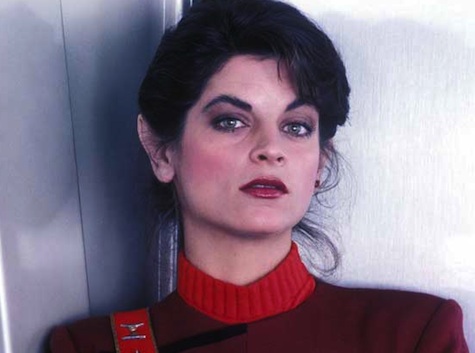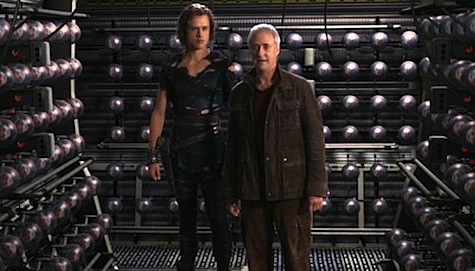Though there is some debate, The Wrath of Khan is consistently and correctly praised as being the best of all of the Star Trek films. And while Trekkies might debate on its influence, there is something essential about The Wrath that sets it apart from all the other movies, and really, every other version of Star Trek. The movie is what everyone wants out of Star Trek, and yet contains its own emotional rules that fly in the face of the rest of Star Trek. It is truly unique and great.
But, like a lot of cinematic triumphs, The Wrath almost wasn’t the film we know it to be and it has an odd legacy. Because it’s 30 years to the day it was released, here are five big things you might not know about the most famous Trek of them all.
5.) Originally, Spock Didn’t Die Because Spock Wasn’t In the Script

Leonard Nimoy’s contemporary love affair with Star Trek and Star Trek fandom wasn’t quite the same back in the 1970s and early 1980s. Instead, Nimoy had to be dragged kicking and screaming to appear in Star Trek: The Motion Picture, and was originally not going to be involved in the aborted second Star Trek TV show, Star Trek: Phase II. So, when the first person assigned to script writing duty—producer Harve Bennett—sat down to write a script, Spock wasn’t really in it. This script was called Star Trek II: War of the Generations and featured Khan, Kirk’s son, and a renegade Federation colony. To help him with the script, Bennet brought in Jack B. Sowards, who introduced the idea of killing Spock off as a way to coerce Nimoy back into the fold. Nimoy was told Spock would be offed early in the script. It worked. Nimoy came back.
4.) Nicholas Meyer Wrote the Shooting Script in 12 Days, Waived Screenwriting Credit
Though detailed much better in this awesome excerpt from his memoir, Director Nicholas Meyer was attached to Star Trek II late in the game. At this point there were various versions of the script floating around, and Meyer felt the only way to get something he could shoot was to cobble all of them together into one story. Harve Bennett told him they had 12 days to get ILM a script, which was not enough time to get Meyer a screenwriting deal. Because of the time constraints, Meyer told them he would forgo screenwriting credit in the interests of fixing the script. The rest is history.
3.) Meyer Wanted the Title of Star Trek II to Be The Undiscovered Country
According to William Shatner’s Star Trek Movie Memories book, Meyer really, really wanted to have the subtitle of Star Trek II reference the famous “undiscovered country” line from Hamlet’s well-known “To be or not to be” soliloquy. Apparently, the studios were adamantly against this idea, and instead wanted to call the movie The Vengeance of Khan. At the time, the third Star Wars film was still know as Revenge of the Jedi, a point which Meyer made to the studio. (Reportedly, he also didn’t care for the Vengeance title.) In the end, it was changed to The Wrath of Khan, to avoid the Vengeance/Revenge problem, which didn’t matter with the re-titled Return of the Jedi. According to the same book, Meyer didn’t like that title either. Of course, Meyer eventually got his way when he directed Star Trek VI: The Undiscovered Country, by calling the film well you get it.
2.) Saavik Is Half Romulan. Was Almost a Dude.

Though mentioned in various versions of the screenplay, Saavik was originally conceived to be half-Romulan, which would account for some of her overt emotionalism. Her utterance of the very un-Vulcan word “damn” at the beginning of the film might be an indication of this. Much of Saavik’s half-Romulan heritage is fleshed out in various Star Trek novels and comics, notably The Pandora Principle by Carolyn Clowes, which details Saavik’s origin, and how she first entered Starfleet Academy.
Another earlier version of the script had Saavik entering a relationship with David, something which is mildly hinted at in both Star Trek II and Star Trek III. But even earlier than that, she was set to be a male Vulcan protégé of Spock’s named Wicks.
1.) The Wrath is Rarely Directly Referenced in Subsequent Films or TV Shows

Naturally the next two Trek films both deal with the fallout from the events of The Wrath, but direct references (not homages!) to the events of this film in The Next Generation, Deep Space Nine, Voyager and Enterprise are very uncommon. Sure, it’s a big universe, but when you consider how popular this movie is, one would think Khan, the Genesis Device and Spock dying would be brought up more often. Khan himself is directly name-checked in the Deep Space Nine episode “Doctor Bashir, I Presume” in reference to the fact Julian Bashir is genetically engineered. Picard references Khan in “A Matter of Time” when chatting with faux-future historian Berlinghoff Rasmussen.
The biggest Khan snub of all? Carol Marcus is never once mentioned again by anyone in the original series movies, nor TNG, nor DS9. Ever. No one brings up poor Carol Marcus until Captain Janeway makes an odd reference to Dr. Marcus (or maybe David too?) in the episode “The Omega Directive.” This is interesting because in early drafts of The Wrath, the Genesis Device was referred to as “The Omega Device.”
The biggest reference to The Wrath in a spin-off series actually comes from Enterprise, in the three episodes “Borderland,” “Cold Station 12,” and “The Augments” where an entire crew of genetically engineered augments runs around the galaxy causing problems and talking about Khan.
Special Bonus: Owen Wilson Time-Travelled And Played Khan in An Alternate Universe
That’s where we got the top image. Really. (Not really.)
More Khan trivia? Tell us below! This will be your big chance to get away from it all.
Big thanks to Memory Alpha and Bardfilm for research for this article.
Stubby the Rocket is the Tor.com mascot. Stubby wants to know who has been holding up the damn elevator and if she changed her hair style.










